Yihua Ma
Networked Collaborative Sensing using Multi-domain Measurements: Architectures, Performance Limits and Algorithms
Feb 23, 2024Abstract:As a promising 6G technology, integrated sensing and communication (ISAC) gains growing interest. ISAC provides integration gain via sharing spectrum, hardware, and software. However, concerns exist regarding its sensing performance when compared to dedicated radar systems. To address this issue, the advantages of widely deployed networks should be utilized, and this paper proposes networked collaborative sensing (NCS) using multi-domain measurements (MM), including range, Doppler, and two-dimension angle of arrival. In the NCS-MM architecture, this paper proposes a novel multi-domain decoupling model and a novel guard band-based protocol. The proposed model simplifies multi-domain derivations and algorithm designs, and the proposed protocol conserves resources and mitigates NCS interference. To determine the performance limits, this paper derives the Cram\'er-Rao lower bound (CRLB) of three-dimension position and velocity in NCS-MM. An accumulated single-dimension channel model is used to obtain the CRLB of MM, which is proven to be equivalent to that of the multi-dimension model. The algorithms of both MM estimation and fusion are proposed. An arbitrary-dimension Newtonized orthogonal matched pursuit (AD-NOMP) is proposed to accurately estimate grid-less MM. The degree-of-freedom (DoF) of MM is analyzed, and a novel DoF-based two-stage weighted least squares (TSWLS) is proposed to reduce equations without DoF loss. The numerical results show that the performances of the proposed algorithms are close to their performance limits.
Energy-efficient Integrated Sensing and Communication System and DNLFM Waveform
Sep 18, 2023



Abstract:Integrated sensing and communication (ISAC) is a key enabler of 6G. Unlike communication radio links, the sensing signal requires to experience round trips from many scatters. Therefore, sensing is more power-sensitive and faces a severer multi-target interference. In this paper, the ISAC system employs dedicated sensing signals, which can be reused as the communication reference signal. This paper proposes to add time-frequency matched windows at both the transmitting and receiving sides, which avoids mismatch loss and increases energy efficiency. Discrete non-linear frequency modulation (DNLFM) is further proposed to achieve both time-domain constant modulus and frequency-domain arbitrary windowing weights. DNLFM uses very few Newton iterations and a simple geometrically-equivalent method to generate, which greatly reduces the complex numerical integral in the conventional method. Moreover, the spatial-domain matched window is proposed to achieve low sidelobes. The simulation results show that the proposed methods gain a higher energy efficiency than conventional methods.
OTFDM: A Novel 2D Modulation Waveform Modeling Dot-product Doubly-selective Channel
Apr 04, 2023Abstract:Recently, a two-dimension (2D) modulation waveform of orthogonal time-frequency-space (OTFS) has been a popular 6G candidate to replace existing orthogonal frequency division multiplexing (OFDM). The extensive OTFS researches help to make both the advantages and limitations of OTFS more and more clear. The limitations are not easy to overcome as they come from OTFS on-grid 2D convolution channel model. Instead of solving OTFS inborn challenges, this paper proposes a novel 2D modulation waveform named orthogonal time-frequency division multiplexing (OTFDM). OTFDM uses a 2D dot-product channel model to cope with doubly-selectivity. Compared with OTFS, OTFDM supports grid-free channel delay and Doppler and gains a simple and efficient 2D equalization. The concise dot-division equalization can be easily combined with MIMO. The simulation result shows that OTFDM is able to bear high mobility and greatly outperforms OFDM in doubly-selective channel.
Waveform Design and Hybrid Duplex Exploiting Radar Features for Joint Communication and Sensing
Jul 07, 2022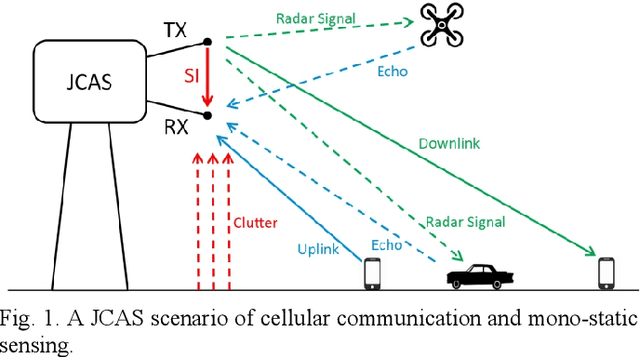
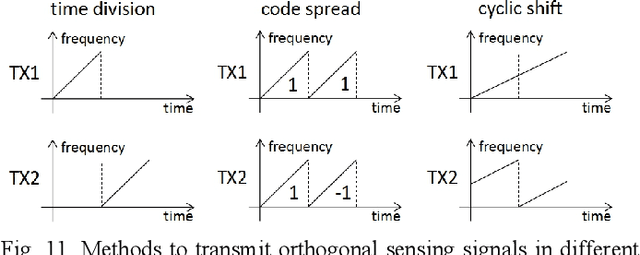
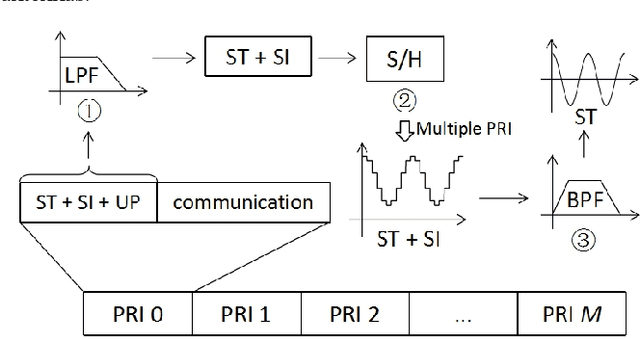
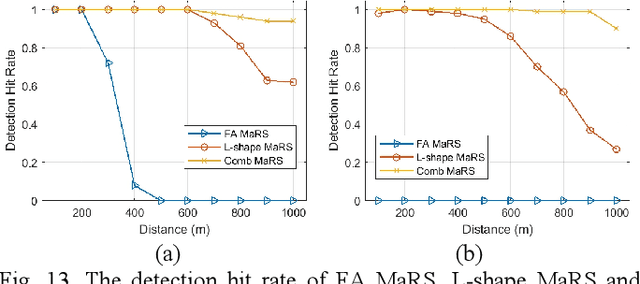
Abstract:Joint communication and sensing (JCAS) is a very promising 6G technology, which attracts more and more research attention. Unlike communication, radar has many unique features in terms of waveform criteria, self-interference cancellation (SIC), aperture-dependent resolution, and virtual aperture. This paper proposes a waveform design named max-aperture radar slicing (MaRS) to gain a large time-frequency aperture, which reuses the orthogonal frequency division multiplexing (OFDM) hardware and occupies only a tiny fraction of OFDM resources. The proposed MaRS keeps the radar advantages of constant modulus, zero auto-correlation, and simple SIC. Joint space-time processing algorithms are proposed to recover the range-velocity-angle information from strong clutters. Furthermore, this paper proposes a hybrid-duplex JCAS scheme where communication is half-duplex while radar is full-duplex. In this scheme, the half-duplex communication antenna array is reused, and a small sensing-dedicated antenna array is specially designed. Using these two arrays, a large space-domain aperture is virtually formed to greatly improve the angle resolution. The numerical results show that the proposed MaRS and hybrid-duplex schemes achieve a high sensing resolution with less than 0.4% OFDM resources and gain an almost 100% hit rate for both car and UAV detection at a range up to 1 km.
Waveform Design Using Half-duplex Devices for 6G Joint Communications and Sensing
Jan 04, 2022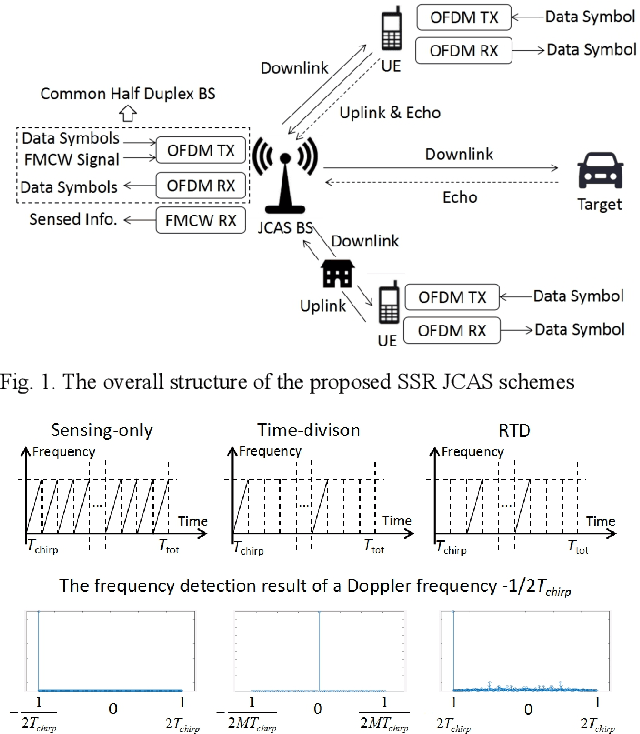
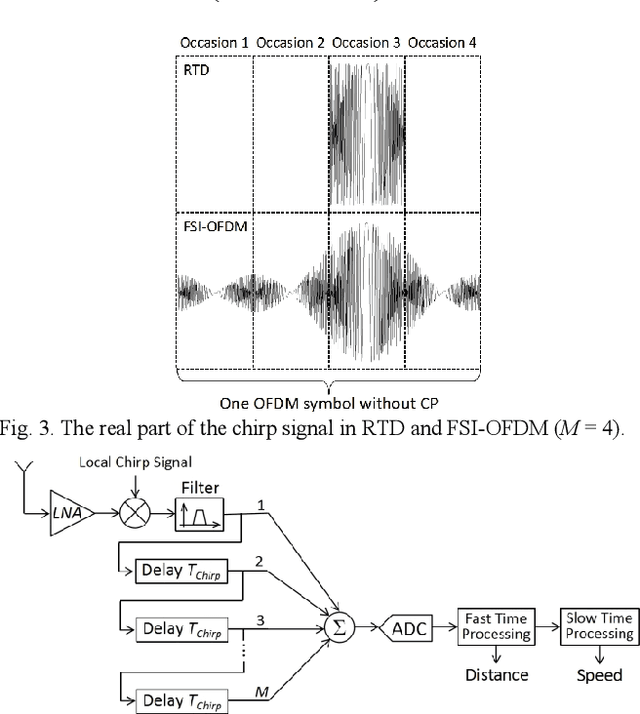
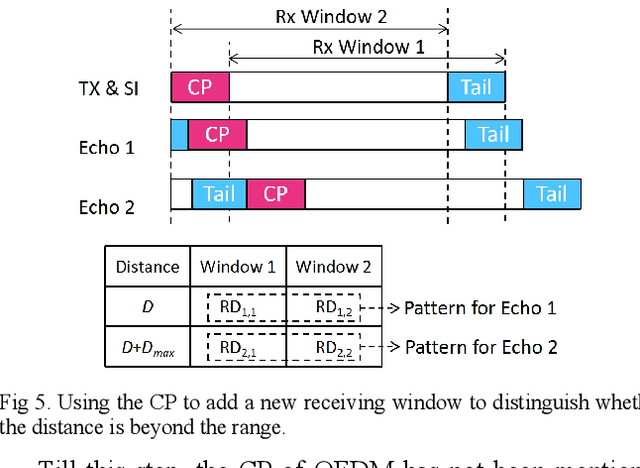

Abstract:Joint communications and sensing is a promising 6G technology, and the challenge is how to integrate them efficiently. Existing frequency-division and time-division coexistence can hardly bring a gain of integration. Directly using orthogonal frequency-division multiplexing (OFDM) to sense requires complex in-band full-duplex to cancel the selfinterference (SI). To solve these problems, this paper proposes novel coexistence schemes to gain super sensing range (SSR) and simple SI cancellation. SSR enables JCS to gain a sensing range of a sensing-only scheme and shares the resources with communications. Random time-division is proposed to gain a super Doppler range. Flexible sensing implanted OFDM (FSIOFDM) is also proposed. FSI-OFDM uses random sensing occasions to gain super Doppler range, as well as utilizes the fixed tail sensing occasions to achieve supper distance range. The simulation results show that the proposed schemes can gain SSR with limited resources.
Contention-based Grant-free Transmission with Extremely Sparse Orthogonal Pilot Scheme
Jun 08, 2021



Abstract:Due to the limited number of traditional orthogonal pilots, pilot collision will severely degrade the performance of contention-based grant-free transmission. To alleviate the pilot collision and exploit the spatial degree of freedom as much as possible, an extremely sparse orthogonal pilot scheme is proposed for uplink grant-free transmission. The proposed sparse pilot is used to perform active user detection and estimate the spatial channel. Then, inter-user interference suppression is performed by spatially combining the received data symbols using the estimated spatial channel. After that, the estimation and compensation of wireless channel and time/frequency offset are performed utilizing the geometric characteristics of combined data symbols. The task of pilot is much lightened, so that the extremely sparse orthogonal pilot can occupy minimized resources, and the number of orthogonal pilots can be increased significantly, which greatly reduces the probability of pilot collision. The numerical results show that the proposed extremely sparse orthogonal pilot scheme significantly improves the performance in high-overloading grant-free scenario.
PDRS: A Fast Non-iterative Scheme for Massive Grant-free Access in Massive MIMO
Dec 25, 2020



Abstract:Grant-free multiple-input multiple-output (MIMO) usually employs non-orthogonal pilots for joint user detection and channel estimation. However, existing methods are too complex for massive grant-free access in massive MIMO. This letter proposes pilot detection reference signal (PDRS) to greatly reduce the complexity. In PDRS scheme, no iteration is required. Direct weight estimation is also proposed to calculate combining weights without channel estimation. After combining, PDRS recovery errors are used to decide the pilot activity. The simulation results show that the proposed grant-free scheme performs good with a complexity reduced by orders of magnitude.
LMMSE Processing for Cell-free Massive MIMO with Radio Stripes and MRC Fronthaul
Dec 25, 2020


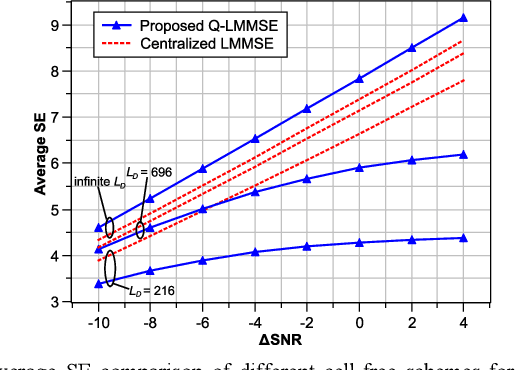
Abstract:Cell-free massive MIMO provides ubiquitous connectivity for multiple users, and implementation using radio stripes is very efficient. Compared with collocated massive MIMO, the major cost includes fronthaul overheads and AP hardware. Maximum ratio combination (MRC) achieves a low fronthaul loading and low-cost AP, but the performance is bad. This letter proposes to implement a quasi-LMMSE (Q-LMMSE) processing using MRC fronthaul design. Q-LMMSE is derived from a standard LMMSE, which gains interference information from MRC signal via singular value decomposition. Simulation results show that the proposed Q-LMMSE increases the spectral efficiency by several times using same MRC fronthaul.
 Add to Chrome
Add to Chrome Add to Firefox
Add to Firefox Add to Edge
Add to Edge